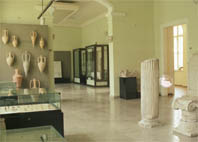|
It was in the winter of the year
72 - 71 BC Odessos was conquered for a short period by
the Roman legions. During the second half of the 1st century
BC and the early 1st century AD the town remained under
the protectorate of the Thracian kingdoms which preserved
their independence. It was later in the year 15 AD
after the formation of the Roman province Mysia that Odessos
was finally included in the realms of the Empire.
 |
The town preserved its
importance as a port, trade, production and cultural
center. In the halls are exhibited imported amphorae,
ceramics, bronze and glass vessels, lamps, decorations
of bronze, agate and amber. Evidence to the broad scope
of the trade activities is a pair of scales, a balance,
commercial lead seals, a part of an inscription quoting
the state prices of goods in the year 301 AD
during the reign of Emperor Diocletianus, lead
ingots imported from Spain, etc.
For the everyday life of
the citizens of Odessos during 1st – 3rd century
AD one can judge from the various writing facilities
– stimuli, ink-holders, a pair of compasses, dice and
pieces, a twelve sided lettered die for telling the
future and others. |
Local
production of the following was developed – ceramics, glass
vessels, bronze and gold decorations. Well developed was also
stone carving – tombstones, columns and construction capitals
were produced.
For the cultural and sports life
one can judge from the lamps representing theatre masks, a
silver statuette of an actor, sports belongings – weights
for lifting and throwing, bronze scrapers, relieves depicting
sport scenes and a tomb stone of an athletic. Special attention
was given to the circus and the gladiator fights. Inscriptions
on marble serving as 'Posters' for announcing gladiator fights
show that the citizens of Odessos were not indifferent to
amusements of that kind.
|
